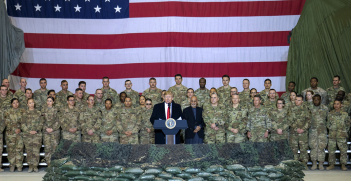The Afghanistan Pull-Out is Bad News for Pakistan
America’s decision to pull out its remaining troops from Afghanistan and thus facilitate a probable Taliban military take-over is bad news for Pakistan and the region in the long-term. It may result in a resurgence of terrorism, rise in refugees, and tensions across borders.
The only surprise in President Joe Biden’s much anticipated announcement on 14 April to withdraw the remaining 2,500 US military personnel from Afghanistan was not the withdrawal itself—that was always going to happen—but the date of the departure and the lack of conditions attached to it. According to the February 2020 agreement between the Trump administration and the Taliban, the US and other non-American troops, about 7,000 including 80 Australian military personnel, were to be out by 1 May, but only if some security conditions were met. Instead, President Biden decided to give himself an additional four months to withdraw—without any conditions attached to it, with the process completed by 11 September, the 20th anniversary of the Al Qaeda terrorist attacks in the US. This decision went against the recommendation of President Biden’s top military commanders, who argued for a continued modest presence to collect intelligence and provide support to the Afghan National Defence and Security Forces (ANDSF).
President Biden’s principal argument for unilaterally leaving Afghanistan was that the US had accomplished its mission, that “Afghanistan would not be used as a base from which to attack our homeland again.” While the US has indeed destroyed Al Qaeda, at least in Afghanistan, it has not met the other major objective President Barack Obama added in December 2009, which was to “reverse the Taliban’s momentum and deny it the ability to overthrow the government.” It was becoming increasingly evident that stopping the Taliban militarily was an impossible goal. But with all foreign troops soon to leave, Biden has just made the Taliban’s objective of taking over the reins of power that much easier.
The day after Biden’s announcement, US Secretary of State Antony Blinken travelled to Kabul to personally break the bad news to Afghan President Ashraf Ghani. He stressed that this withdrawal didn’t mean an end to the American commitment to Afghanistan, which would include aid and advice to the military and the government. Publicly, Ghani respected the US decision, but privately and not surprisingly, he was reportedly fuming. He knows his days in power are numbered.
In September 2009, Sir David Richards, head of the British Army, stated that a perceived defeat of the US and NATO would have a “hugely intoxicating impact on extremists worldwide.” And this is precisely what has happened with this withdrawal. Accordingly, now that Washington has publicly announced the departure date, one that the Taliban will surely mark in their diary, there is absolutely no need or incentive for the Taliban to continue to go through the motions of negotiating with the US or the Afghan government. They’ve already announced that they won’t be attending the forthcoming NATO-sponsored Istanbul Conference to discuss the Afghan peace process.
The withdrawal, before and after
The Taliban, which has up to 85,000 full-time fighters and controls about twenty percent of the country, will continue to conduct military operations in order to take more territory from government forces. However, given that they will have been warned by President Biden that they would be hit hard if they do, it’s unlikely that the Taliban will target the departing forces. The Taliban has not targeted US and Coalition forces since signing the February 2020 agreement. There’s obviously no point in needlessly antagonising them on their way out.
Notwithstanding President Ghani stating that the ANDSF is “fully capable of defending its people,” once the critical American aircover is withdrawn, it will be even more difficult for Afghan forces to stand up to the Taliban. According to Ghani, 3560 ANDSF troops were killed between the signing of the 2020 agreement and 21 July 2020 alone. Such a high fatality rate is unsustainable in the long term. Accordingly, we can expect the roughly 300,000-strong ANDSF to begin to unravel through desertion, troops joining the various warlords, or even defecting to the Taliban.
As noted above, despite external pressure, including from Pakistan, the Taliban will boycott negotiations until all foreign forces have departed. And it’s most unlikely that they will participate in the so-called peace process after the withdrawal is completed. With the Taliban military noose tightening on the cities and the ever increasing number of assassinations of political, government, religious, and civil society leaders, we can expect civilians to begin to make their way to the borders with Iran and Pakistan in anticipation of a likely increase in violence, reminiscent of the early 1990s following the departure of the Soviet troops.
But even with the departure of the Coalition forces, the Taliban will not capture Kabul overnight. It may well take a couple of years. They will have to contend with not only the ANDSF but also the various ethnic-based warlords, such as the Uzbek leader Abdul Rashid Dostum, Tajik political leader Atta Muhammad Nur, and Hazara warlord Abdul Ghani Alipoor, who will be flexing their military muscles to establish their respective zones of influence. The likelihood of inter-ethnic civil war will lead to more refugees trying to cross the borders, particularly the border with Pakistan.
The knock-on effect for Pakistan
Washington’s decision to withdraw militarily from Afghanistan without any conditions attached is absolutely not what Pakistan wanted. Following Biden’s announcement, Pakistan’s foreign ministry pointedly reaffirmed the importance it attached to having a withdrawal of foreign troops coinciding with progress in the peace process. Pakistan, which had played a critical role in bringing the Taliban to the negotiating table, was hoping to see the Taliban brought peacefully into the political space, including possibly with the establishment of an interim government that would include them.
However, regardless how the Taliban comes back to power after a 20-year absence, which increasingly looks like it will be violently, this will be bad news for Pakistan. For the last 25 years, Islamabad’s policy has been to support the Pashtun-dominated Taliban—directly and tacitly—as an insurance policy against India’s support for the other ethnic groups, such as the Tajiks, Uzbeks, and Hazaras. This was always a bad policy. There’s absolutely no guarantee that, once in government, the Taliban’s interests will align with Pakistan’s.
Although Pakistan was one of the few countries to recognise the Taliban government between 1996 and 2001 and provided asylum to the Taliban leadership for 20 years, the relationship has always been ambivalent. This was evident when the Taliban were in power. They continued to refuse to recognise the Durant Line, the de facto international border. More worrisome for Pakistan is that the establishment of a Taliban-run Islamic Emirate would give a real fillip to those Pakistani terrorist groups, such as the Pakistan Taliban, the Islamic State, and other fellow ideological travellers who oppose the government, which have found refuge in eastern Afghanistan. The Taliban would be sympathetic to their cause and, accordingly, would probably not try to stop them from conducting terrorist raids into Pakistan.
So, all in all, more Afghan refugees and a resurgence of terrorism would all be bad news for Pakistan, a 220-million strong, nuclear-armed country already teetering under the weight of a collapsing economy, an out-of-control COVID-19 pandemic, rising sectarian extremism, and a tense relationship with India. Biden’s decision to unilaterally withdraw from Afghanistan—effectively leaving it to its own devices, may well have planted the seed for a much bigger regional problem down the road.
Dr Claude Rakisits is an Honorary Associate Professor in the Department of International Relations at the Coral Bell School of Asia Pacific Affairs at the Australian National University. He tweets @ClaudeRakisits. His publications can be assessed on his website: www.Geopolitical-Assessments.com
This article is published under a Creative Commons License and may be republished with attribution.





